ATI RN Proctored Nursing Care of Children Form B
Document Content and Description Below
1. A nurse is providing education to the parent of a child who has cystic fibrosis and has a prolapsed rectum. The nurse should teach that which of the following is a cause of this complication: a.... Bulky stools b. Weakened rectal sphincter c. Elevated pancreatic enzymes d. Decreased intra abdominal pressure 2. A pre-schooler is admitted to the emergency department with full thickness third degree burn over 45% of his body. Which of the following actions should the nurse take first: a. Administer IV morphine b. Administer IV antibiotics c. Administer IV solutions d. Administer total parenteral nutrition 3. A nurse is providing teaching to a parent of a pre-schooler who has Tinea Capitis. Which of the following should the nurse include in the teaching: a. Apply 1 to 20 burrow’s solution compressed to the lesions b. Apply hydrocortisone cream to the lesions twice daily c. Seal and wash toys in plastic bag for two weeks d. Leave the shampoo on the scalp for 5 to 10 minutes 4. A nurse is caring for a child who has sickle cell anemia. Which of the following signs of acute chest syndrome should the nurse report to the primary care provide immediately: a. Congestive cough b. Dilute hearing c. Hct of 10g/dl d. Systolic murmur 5. A nurse is assessing a 3month old infant for suspected intussusception. Which of the following findings should the nurse expect: a. Jelly-like stool b. Board-like abdomen c. Projectile vomiting d. Oliguria 6. A nurse is planning a teaching session for parents regarding infant development. Which of the following parent activities regarding play should the nurse include in the teaching: a. Encourage the infant in one on one play b. Promote play with other infants c. Provide visual stimulation with pastel colored toys d. Give the infant a large piece puzzle 7. A school-aged child with sickle cell anemia has been admitted in vasoocclusive crisis. Which of the following assessment findings should the nurse recognize as an emergency? a. Slurred speech b. Fever of 38.30 C (1010 F) c. Hematuria d. Pain level of 7 on a faces scale 8. A nurse in an emergency department is assessing a child who was in a motor vehicle accident. Which of the following assessment findings require immediate intervention: a. Dilated and fixed pupils b. Disorientation to person and place c. Positive Babinski reflex d. Restless and irritable 9. A nurse is assessing a child who has sustained a head injury. During the assessment, the nurse observes clear drainage leaking from the child’s nose. Which of the following actions should the nurse take? a. Perform naso-tracheal suctioning b. Test the nasal secretions for glucose c. Maintain direct lighting on the child d. Lower the head of the bed 10. A nurse at a provider’s office is preparing a newborn for a routine heel puncture. Which of the following actions should the nurse take? a. Administer tolectin (tolmetin) prior to the procedure b. Apply EMLA cream to the heel after the procedure c. Prepare concentrated sucrose for oral administration d. Place the new born in an extended position 11. A nurse is caring for a child who has rheumatic fever. Which of the following is an indication that the child has developed carditis? a. Carotid bruit b. Chest pain c. Hypotension d. Cyanosis 12. A parent calls the clinic asking for pinworm testing information, the nurse should advise the parent to perform the test at which of the following times? a. Immediately after child has a bowel movement b. After being on a clear diet for 24hrs c. Immediately after the child awakes in the morning d. After soaking for 20 minutes in a warm bath 13. A nurse is educating the parents of an infant who has mild gastroesophageal reflux. Which dietary adjustment should the nurse recommend? a. Provide a little sprout formula b. Administer nasogastric feedings c. Thicken feedings with rice cereal d. Place infant in a lateral position for one hour after feedings 14. A nurse is teaching an adolescent client about managing asthma and using a peak respiratory flow meter. Which of the following by the client demonstrates an understanding of the teaching: a. I will use my peak flow meter whenever I feel short of breath b. I will continue to take my medication when my peak flow meter is in the green zone c. I need to use the average of three readings when I measure my flow rate d. My asthma is being controlled if my flow rate is in the yellow zone 15. A nurse is instructing the parent of an infant who has clubfeet and has cast applied. Which of the following statements by the parent indicates a need for further teaching: a. My baby will need to return to have his cast changed weekly b. I need to check my baby’s toes for any discolorations daily c. My baby will need to have surgery at 18 months if his toes aren’t fixed d. I will check the skin around my baby’s cast at every diaper change. 16. A nurse assesses an infant that is admitted for acute gastroenteritis. Which of the following is the priority finding? a. Decreased tears b. Capillary refill of 5 seconds c. Heart rate 150/min d. Dry mucous membranes 17. A nurse is planning to teach a nutrition class for preschoolers. Which of the following is an appropriate instructional strategy? (Select all that apply.) a. Offer written handouts b. Limit the teaching session to 45 minutes c. Use simple language d. Incorporate games into the lesson e. Provide concrete examples 18. A nurse is caring for a toddler who has a fever, high-pitched cry, irritability and vomiting. Which of the following is an appropriate action for the nurse to take? a. Administer 81mg of Aspirin b. Place the toddler in a cold water bath c. Place the toddler in a supine position d. Pad the rails of the bed 19. A nurse is reviewing the morning lab results for an infant who is receiving Digoxin and Lasix for the treatment of heart failure. Which of the following should the nurse report to the provider: a. Sodium 140 mEq/L b. Calcium 10.2 mg/dL c. Chloride 100 mEq/L d. Potassium 3.2 mEq/L 20. A nurse is caring for a school aged child who has an arm cast applied 8 hours ago. Which of the following findings should alert the nurse of complications related to the casting: a. Child rates pain of 5 on a scale from 0 to 10 b. Child’s hands are cool bilaterally c. Child reports tightness at the wrist d. Child grasp is weak 21. A nurse is performing a neurological examination on a 15-month-old child. Which of the following is an expected normal finding? a. Negative Babinski reflex b. Presence of Moro reflex c. Absence of corneal reflexes d. Positive palmar grasp 22. Which of the following actions indicates to the nurse that the parent of a preschooler is using an age-appropriate disciplinary technique? a. Explains to the child why her behavior is unacceptable ? b. Places the child in time out after misbehaving c. Allows the child to choose the consequence for her misbehavior d. Assigns an extra chore for the misbehavior 23. A nurse is caring for an infant who is pre-operative for the treatment of mild myelomeningocele. In which of the following positions should the nurse place the infant: a. Side-lying b. Supine c. Prone d. Semi-Fowlers 24. A nurse is providing postoperative care for an infant who has pyloric stenosis. Which of the following actions should the nurse take? a. Use a re-breather mask to provide oxygen b. Place the infant in a supine position c. Initiate feedings with clear fluids d. Weigh the infant every 48 hours 25. A nurse is admitting a child with tonic clonic seizures. Which of the following is the priority to have in the room: a. Pulse ox meter b. Oxygen therapy c. Valve mask d. Suction equipment 26. An infant has had a cardiac catheterization with a right femoral entry to diagnose a possible congenital heart defect. Following this procedure, the nurse should be concerned about which of the following: a. Cool toes on the right foot b. Weak pedal pulses on both feet c. Positive Babinski on both feet d. Erythema on the right foot 27. A nurse is developing a health program for the parents of school age females. Which of the following regarding sexual maturation should the nurse include: a. Higher body fat content is often highly associated with earlier onset of menarche b. Pubic hair is typically present prior to breast development c. Ovulation begins after sexual maturation is complete d. Menarche signals the beginning of puberty 28. A nurse is assessing a child who has measles (rubella). Which of the following findings should the nurse expect? a. Vesicular rash b. Koplik spots c. Para oximal d. Sternal retractions 29. On the way to the emergency department a parents reports a child accidentally ingested overdose acetaminophen. Which of the following medications should the nurse prepare to administer? a. Naloxone b. Diphenhydramine c. Glucagon d. Acetylcysteine 30. A nurse preceptor is working with a newly licensed nurse in caring for a child that is postoperative for a placement of a tracheaosophageal shunt. Which of the following statements made by the newly licensed nurse indicates a need of further teaching: a. I will ensure that pressure is not applied to the shunt valve b. I will pump the shunt every two hours c. I will keep the head of the bed flat for two hours d. I will offer prescribed pain medication as needed 31. A nurse is teaching the parents of a toddler who has a new prescription for an oral iron supplement. Which of the following should the nurse recommend for administration with the medication to increase its absorption: a. A protein source b. Orange juice c. Milk d. A whole grain fiber 32. A nurse is evaluating the anticipatory grieving of a parent do to the impending loss of a child. Which response indicates a need for further assessment by the nurse: a. “We will encourage our other children to be involved in the care of our child.” b. “We have contacted hospice to ensure our child does not have pain.” c. “We understand our child will be most comfortable in a hospital.” d. “We have given our child permission to die.” 33. A nurse is assessing an adolescent female. The adolescent’s mother tells the nurse she is concerned that her daughter is too thin. Which of the following assessment findings are consistent with anorexia nervosa? a. Hyperactive deep tendon reflexes b. Lanugo over the back c. Oily skin with acne d. Elevated body temperature 34. A nurse is educating the family of a child regarding hospice care. Which of the following should the nurse include in the teaching: a. “The hospice staff will be the primary care giver of this child.” b. “Hospice staff consider the needs of the family as important as those of this child.” c. “Hospice care will end with the death of the child.” d. “The priority of hospice care is to provide curative treatment for the child.” 35. A nurse is caring for a child who has acute renal failure. Which of the following findings is of priority concern to the nurse? a. Hyperphosphatemia b. Hyponatremia c. Hypocalcemia d. Hyperkalemia 36. A nurse is caring for a breast-feeding infant who is given amoxicillin for an upper respiratory infection. Assessment of the mouth reveals white patches that would not scrape off. Which of the following nursing interventions is appropriate? a. Offer the infant water before feedings b. Discontinue the amoxicillin c. Administer antifungal medication after feedings d. Give the infant formula instead of breast milk 37. A nurse is caring for an infant admitted with hydrocephalus, and increased intracranial pressure. Which of the following findings should the nurse expect? a. Decreased occipital frontal circumference b. A depressed fontanel c. Unresponsive to physical stimuli d. A high-pitched cry 38. A nurse is caring for a toddler who is postoperative following the repair of a cleft palate. Which of the following interventions by the nurse is appropriate? a. Restrain arms at the elbows b. Feed with a spoon c. Monitor oral temperature d. Provide pacifier for comfort 39. A parent of an infant who is taking Digoxin (Lanoxin) phones the nurse at a clinic because the child has vomited the medication. Which of the following is the priority nursing intervention? a. Tell the father that a repeat dose of medication should not be given b. Verify the prescribed medication regimen c. Determine if the infant has been exposed to others who are ill d. Ask the father about the infant’s urinary output. 40. A nurse is providing teaching to the parents of a toddler about injury prevention. Which of the following safety measure should the nurse include in the teaching? a. Select the toy box with the heavy hand slid b. Provide balloons for play c. Check clothing for loose buttons d. Offer grapes as a snack food 41. A nurse at a pediatric clinic assessing the fluid in caloric intake for an infant who weighs 5 kg and fed a commercial infant formula. The provider recommends that the infants eat just at least 2.5 mg of formula per kg/day, and the formula contains 20 calories per ounce. What is the minimum number of calories per day the infant should consume? 550 Calories 42. A nurse is preparing to administer Tolumedrol IV bolus to a child who weighs 88 pounds. The provider prescribes 1.5 mg/kg/day to administer twice daily. Available is the solumedrol 20 mg/ml. How many ml should the nurse administer with each dose? (Round the answer to the nearest tenth.) 1.5ml 43. A nurse is assessing an infant with appendicitis, which of the following are expected findings? Select all that apply a. Vomiting b. Jaundice c. Bradycardia d. Right lower quadrant pain e. Fever 44. A nurse is caring for a child who received penicillin IM 15 minutes ago. The child is now irritable and restless. Which of the following is the priority action for the nurse to take? a. Administer diphenydramine b. Assess for laryngeal edema c. Initiate continuous ECG monitoring d. Give Epinephrine IV push 45. A nurse is providing teaching to the parents of a 9-month-old infant who is suspected of having spastic cerebral palsy. Which of the following statements is appropriate for the nurse to make? a. “Use an infant walker to increase you baby’s mobility.” b. “Your baby may loose appetite.” c. “Physical therapy will be implemented to reduce contractures.” d. “Your baby’s immunization schedule will be altered.” 46. A nurse is reviewing a school-aged child’s family’s health history. Which of he following indicates a need to obtain lipid screening for the child: a. Grand parent has type 1 Diabetes Mellitus b. Sibling who has cystic fibrosis c. Parent who has high cholesterol d. Parent who has cardiac dysrhythmia 47. A nurse is providing discharge teachings for the parents of a child who has leukemia and is receiving vincristine. Which of the following should the nurse include in the teaching: a. Keep the child out of the sun b. Increase the child’s intake of fluids c. Monitor the child’s heart rate d. Assess the child for epistaxis 48. A nurse is caring for an infant who has tracheal esophageal fistula. Which if the following is an appropriate action for the nurse to take? a. Position the infant prone b. Prepare the infant for surgery c. Administer zantac d. Thicken the infants formula 49. A phone triage nurse is talking to the parents of a toddler who states, “My child has placed a bead in his nose and I don’t know what to do”. Which of the following is an appropriate response by the nurse: a. Try removing the bead using a pair of tweezers b. Take your child to the pediatrician in the morning c. Take your child to the emergency department now d. Have your child blow his nose to dislodge the bead 50. A nurse is teaching an adolescent who has a prescription for nystatin (Troche) orally. Which of the following should the nurse include in the teaching: a. “Rinse immediately following the troche.” b. “You should avoid taking the troche with milk.” c. “Avoid taking anything by mouth 30 mins after taking the troche.” d. “You should chew the troche completely.” 51. A nurse is caring for a child who has a tracheostomy, which of the following techniques should the nurse to suction the child? a. Insert the catheter 2cm beyond the end of the tracheostomy tube b. Remove the catheter while applying intermittent suction c. Instill saline to loosen secretions while suctioning d. Continue suctioning until the secretions are removed 52. A toddler is admitted to the hospital with gastroenteritis and positive for a rotavirus. For which of the following should the nurse wear a gown and don gloves? a. Delivering the food tray b. Administering medication c. Assessing the IV site d. Changing the bed linens 53. A nurse is caring for a child who is postoperative, which of the following findings indicates the need for administration of naloxone? a. Crackles in the lung bases b. Respiratory depression c. Nausea and vomiting d. Tachycardia 54. A nurse is assessing a 3-year-old client. Which of the following developmental milestones should the nurse expect the child to demonstrate? a. Stacking 8 blocks b. Printing one to two letters c. Tying shoe laces d. Using seven word sentences 55. A nurse is caring for an adolescent following a lumbar puncture. Which of the following is an appropriate action for the nurse to take? a. Initiate NPO status b. Place the client in a supine position c. Place a moist warm pack on the lower back d. Apply and eutectic mixture local anesthetics to the puncture site 56. A nurse is planning care for a toddler admitted with acute gastroenteritis. Which of the following should the nurse expect to give? a. Oral rehydration solution b. Bananas or apple sauce c. Chicken or beef broth d. Hypertonic IV solutions 57. A toddler diagnosed with Tetralogy of Fallot becomes hypercapnic with worsening cyanosis. Which of the following actions should the nurse take first? a. Place the toddler in knee chest position b. Initiate Iv fluid replacement c. Provide 100% oxygen by face mask d. Administer morphine 58. A child admitted for acute nephrotic syndrome had been receiving prednisone by mouth for the past week. After reviewing the child’s lab results, which of the following should the nurse report to the primary care provider? a. Serum sodium 142 mEq/L b. Serum potassium 4.0 mEq/L c. White blood cell count 3,000 mm3 d. Platelet count of 298,000/L 59. The nurse is planning to administer Artivan 1.5 mL via IV bolus. Available is the medication via injection 2 g/mL. How many ml should the nurse administer? (Round your answer to the nearest tenth.) 60. A nurse is providing education to the parents of an infant who is being treated with Pavlik harness. Which of the following actions is appropriate when teaching the parents about home care measures: a. Adjust the infant’s harness once a week b. Ensure the infant wears the shirt under the harness c. Apply powder on harness after bathing d. Maintain the infant in an upright position 61. A nurse is caring for an infant who is in the last stage of neuroblastoma. The parents ask, “How can we best help our child now?” Which of the following responses by the nurse is appropriate? a. “Encourage you child’s friends to visit.” b. “Stay close to your child.” c. “Allow your child to see you cry.” d. “Talk to your child about the meaning of death.” 62. A nurse is providing teaching to the parents to a school age child following the placement of a ventricular peritoneal shunt. This nurse understands teaching has been effective when the parents identify which of the following as an indication that the shunt has been displaced? a. Decreased urine output b. Decreased head circumference c. Elevated temperature d. Increased sleeping 63. A nurse is caring for a 4 year old child. After reviewing the chart, which of the following is an appropriate action for the nurse to take? (Click on the exhibit below for additional information) a. Insert a nasogastric tube for suctioning b. Palpate the child’s abdomen for rebound tenderness c. Prepare the child for abdominal CT scan d. Initiate a diet high in protein and calories 64. A nurse is caring for an adolescent who is receiving fentanyl via epidural route. Which of the following is a priority action for the nurse to take: a. Assess skin around the catheter site b. Check blood pressure c. Assess pain level d. Check oxygen saturation 65. A nurse in an acute care facility is caring for a 14-month old toddler who has E.coli. Which of the following actions is appropriate for the nurse to take? a. Administer opioids for pain b. Give an oral antidiuretic agent c. Implement a BRAT diet d. Initiate contact precautions 66. A nurse is providing teaching to the parents of a toddler with failure to thrive. Which of the following should the nurse include in the teaching: a. Hold the infant face to face to maintain eye contact b. Alternate things between several family members c. Introduce several new foods to stimulate the infant’s interest d. Provide a stimulating infant to keep the infant awake 67. A nurse is providing discharge teaching to the parent of a child who experienced status asthmaticus. Which of the following responses by the parent indicates an understanding of the teaching? a. “I will perform chest physiotherapy during an acute attack.” b. “When using a metered-dose inhaler, my child should inhale the quickly exhale medication.” c. “My child will use his bronchodilator before bedtime to prevent wheezing.” d. “I will call the doctor if my child becomes anxious and restless at night.” 68. A 10-month-old infant is undergoing a well infant check up. Which of the following assessment findings should concern the nurse? a. The infant is unable to walk alone b. The infant’s Moro reflex is absent c. The infant’s anterior fontanel was opened d. The infant needs assistance to sit up 69. A nurse is communicating with a child who has hearing loss. Which of the following actions should the nurse take? a. Exaggerate pronunciation of words b. Change positions frequently to maintain attention c. Use touch to initiate communication d. Avoid using facial expressions when speaking 70. An early school aged child continues to have mild discomfort after administration of an analgesic. Which of the following actions should the nurse use? a. Use guided imagery b. Give the child a large coconut to find different designs c. Encourage the child to take a deep breath d. Teach the child to picture a stop sign whenever the pain begin [Show More]
Last updated: 1 year ago
Preview 1 out of 11 pages
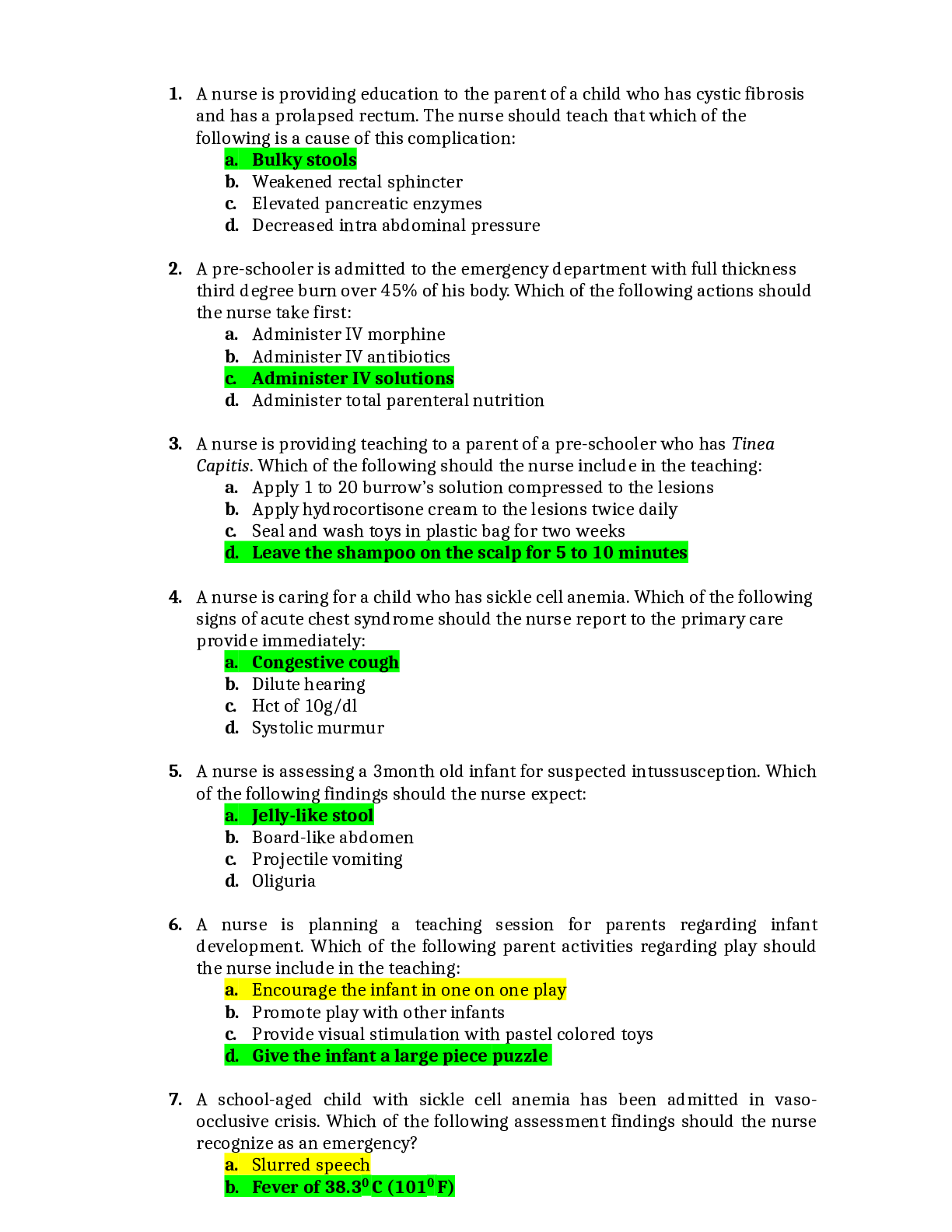
Reviews( 0 )
Document information
Connected school, study & course
About the document
Uploaded On
Nov 14, 2021
Number of pages
11
Written in
Additional information
This document has been written for:
Uploaded
Nov 14, 2021
Downloads
11
Views
1271

.png)


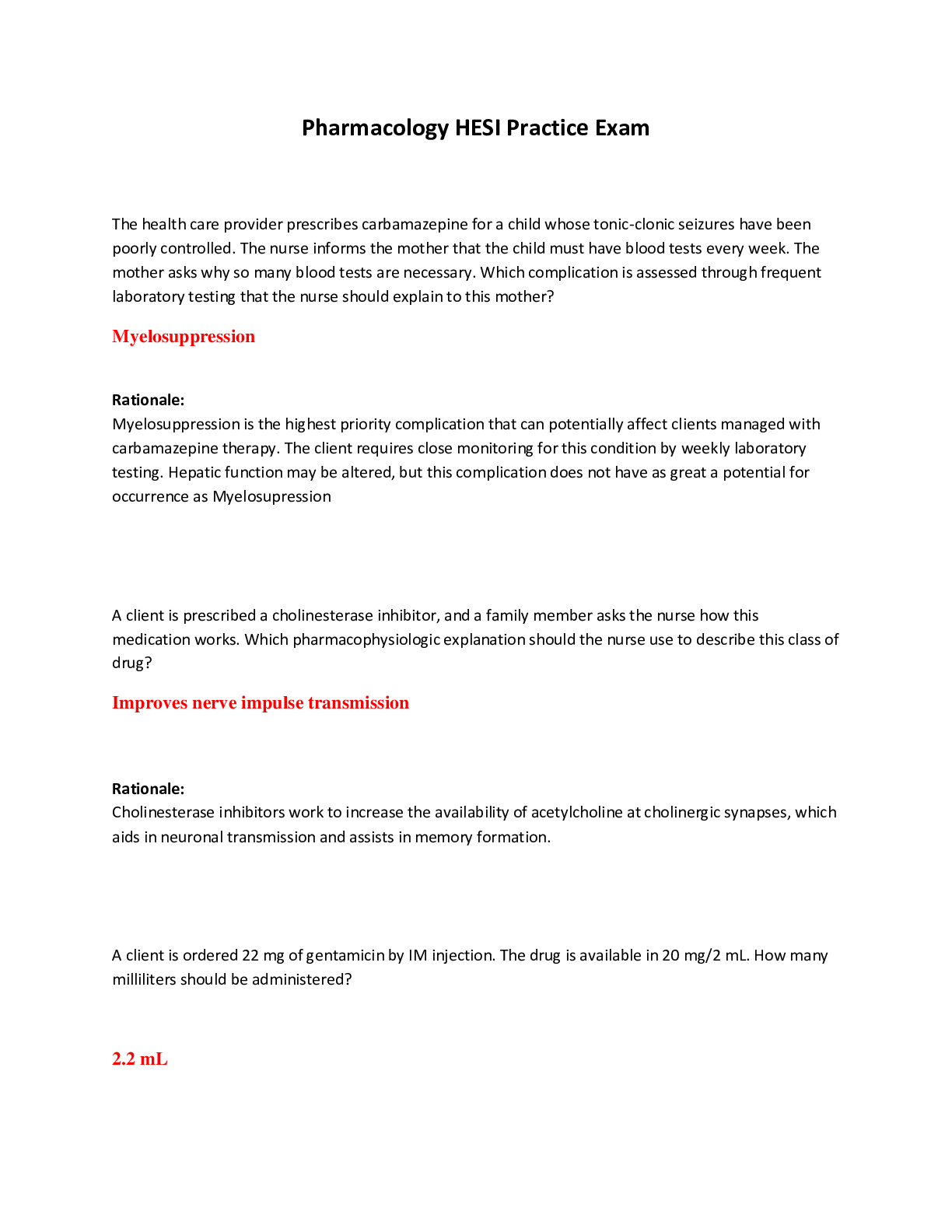


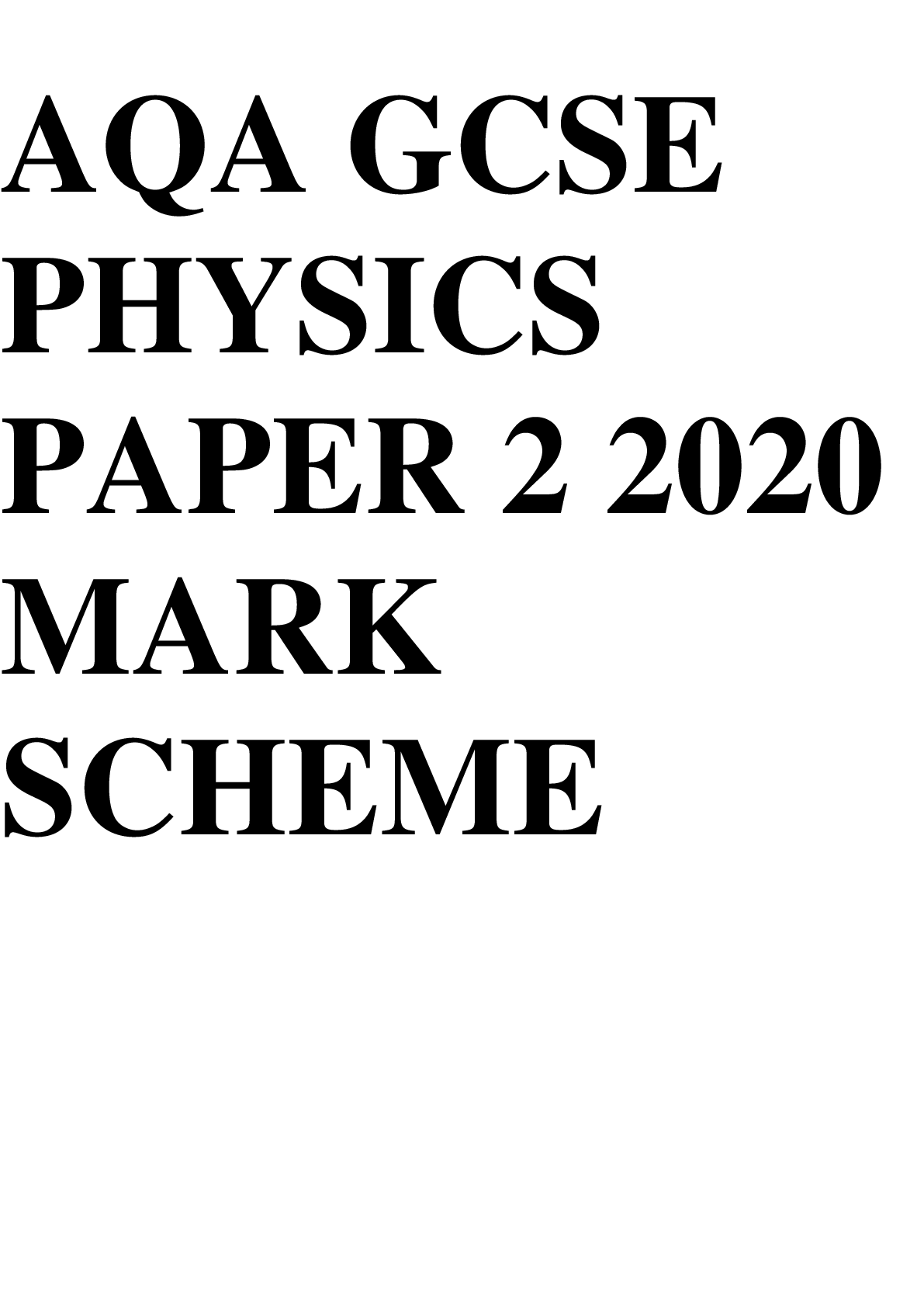

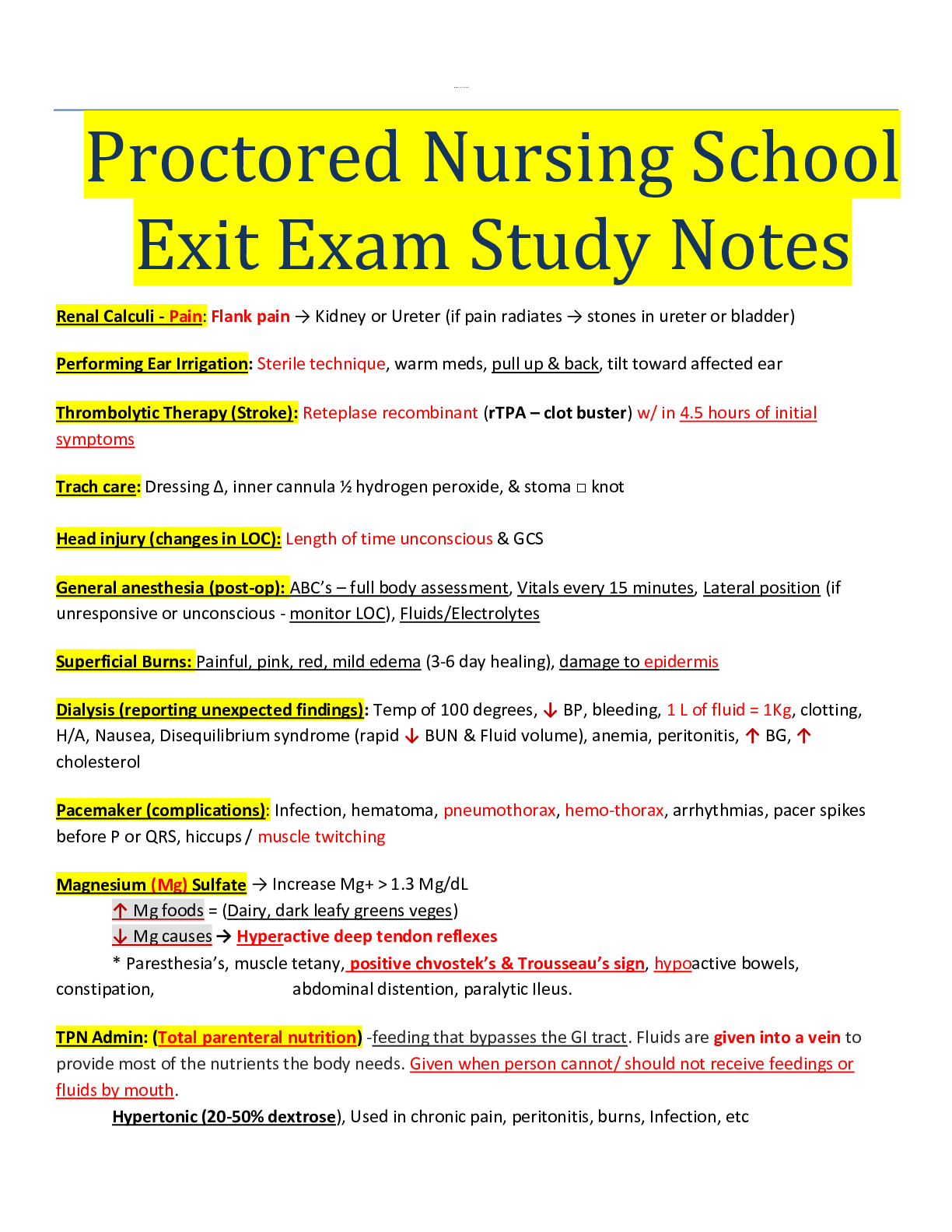
.png)
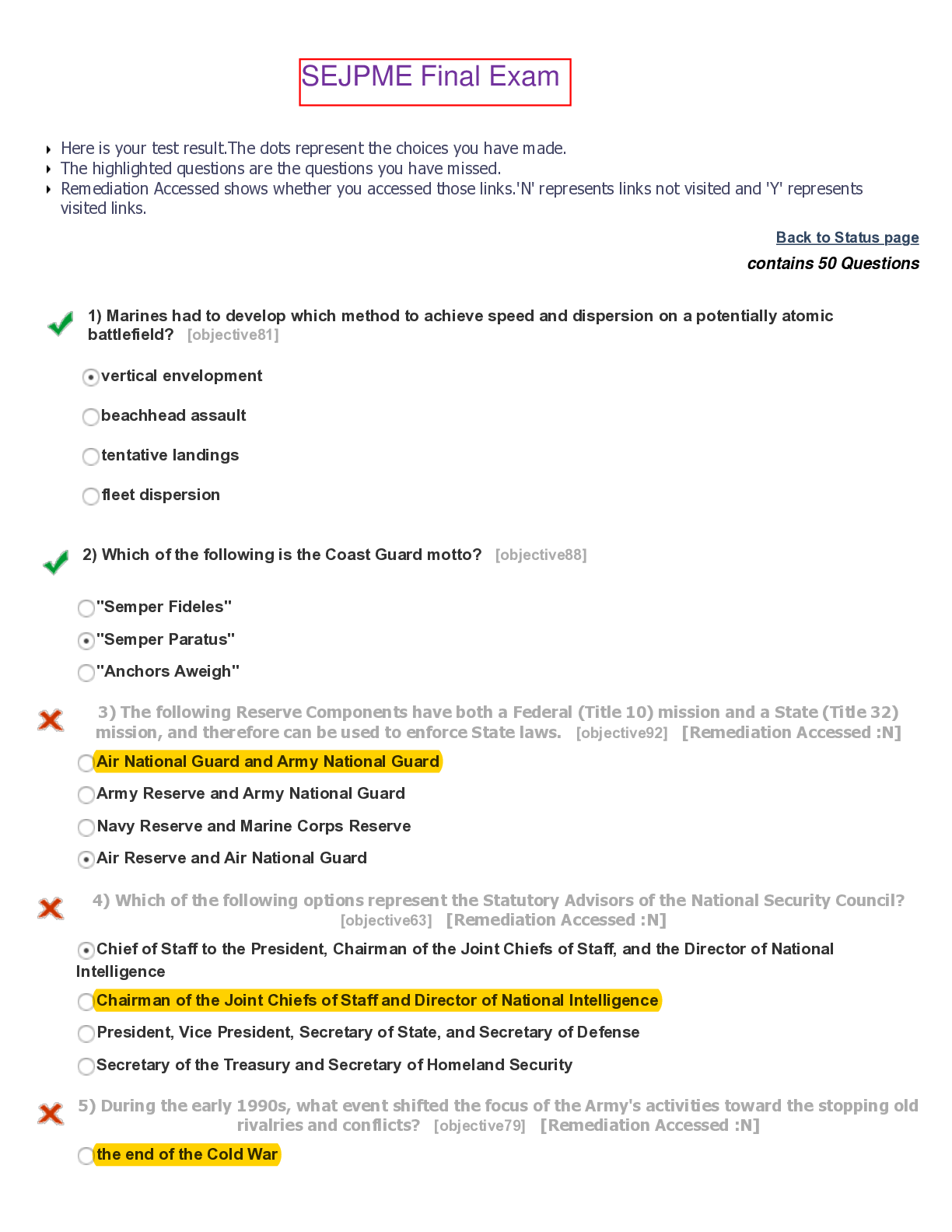
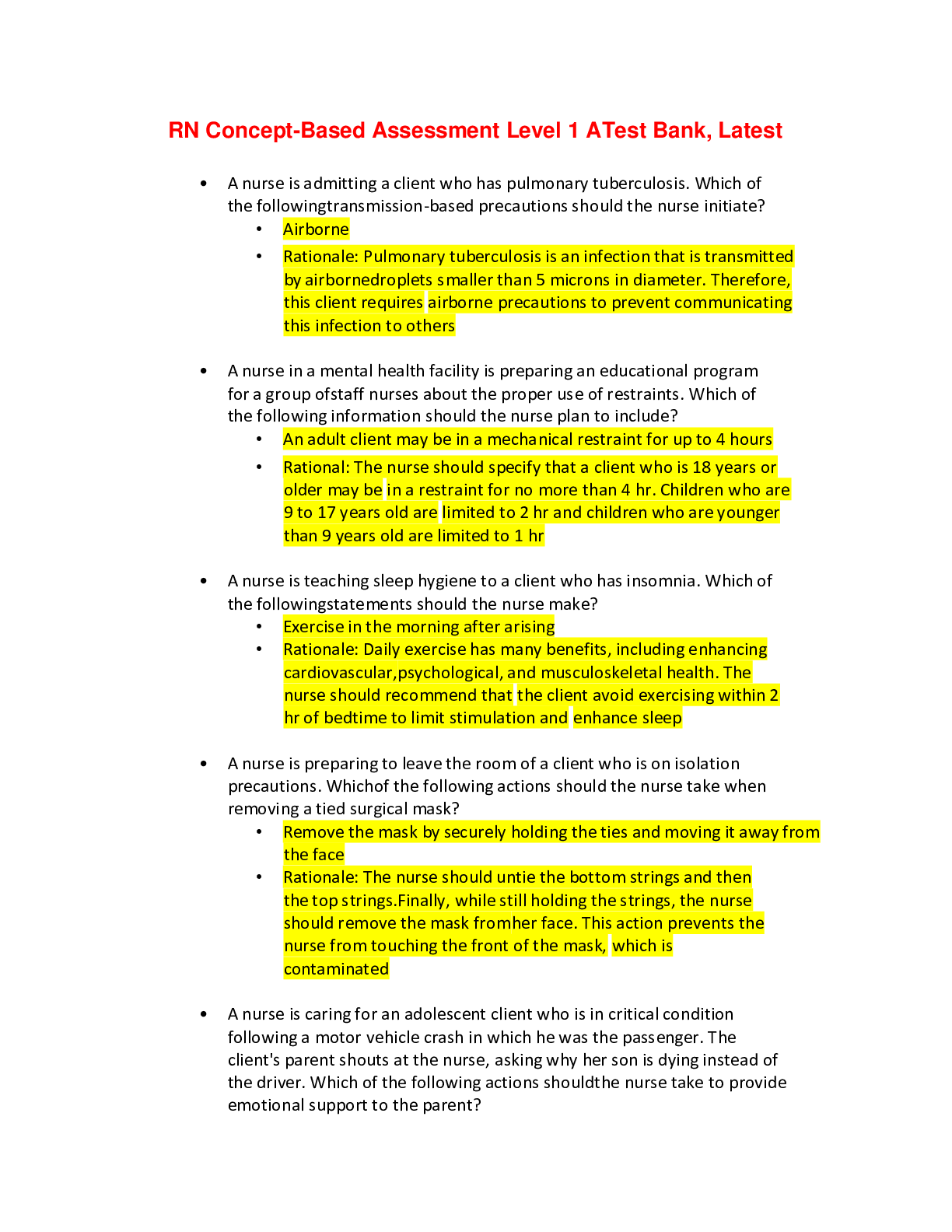
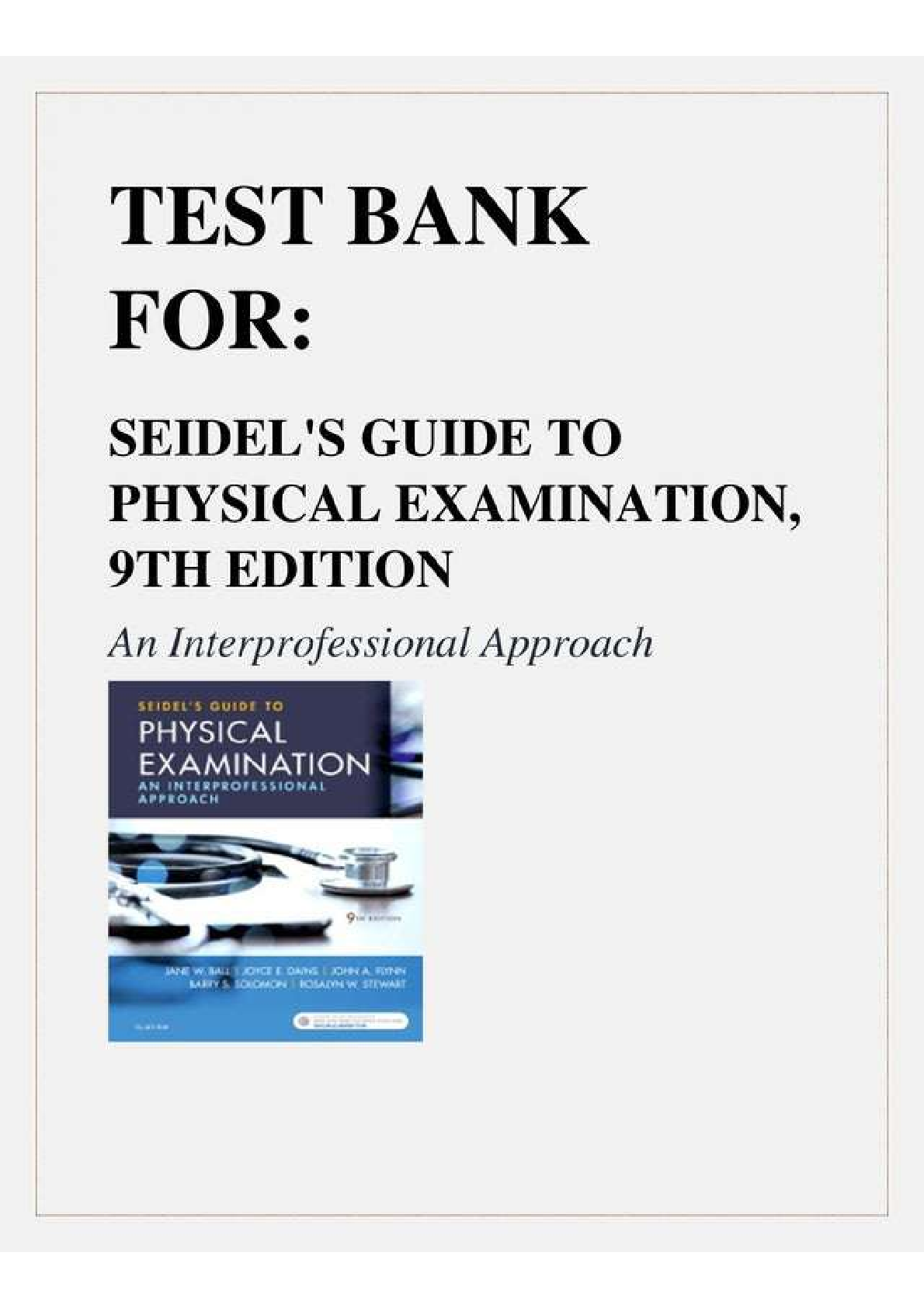

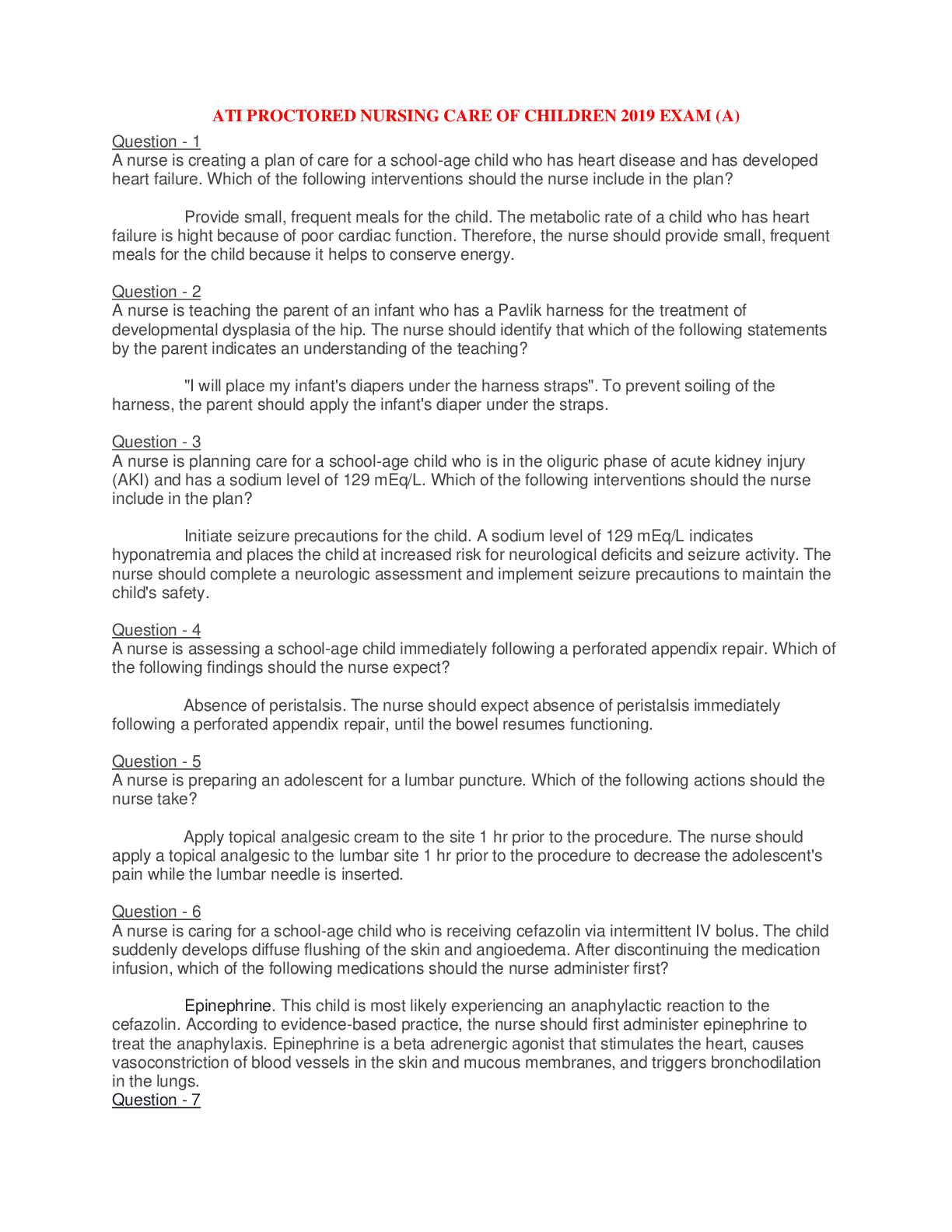
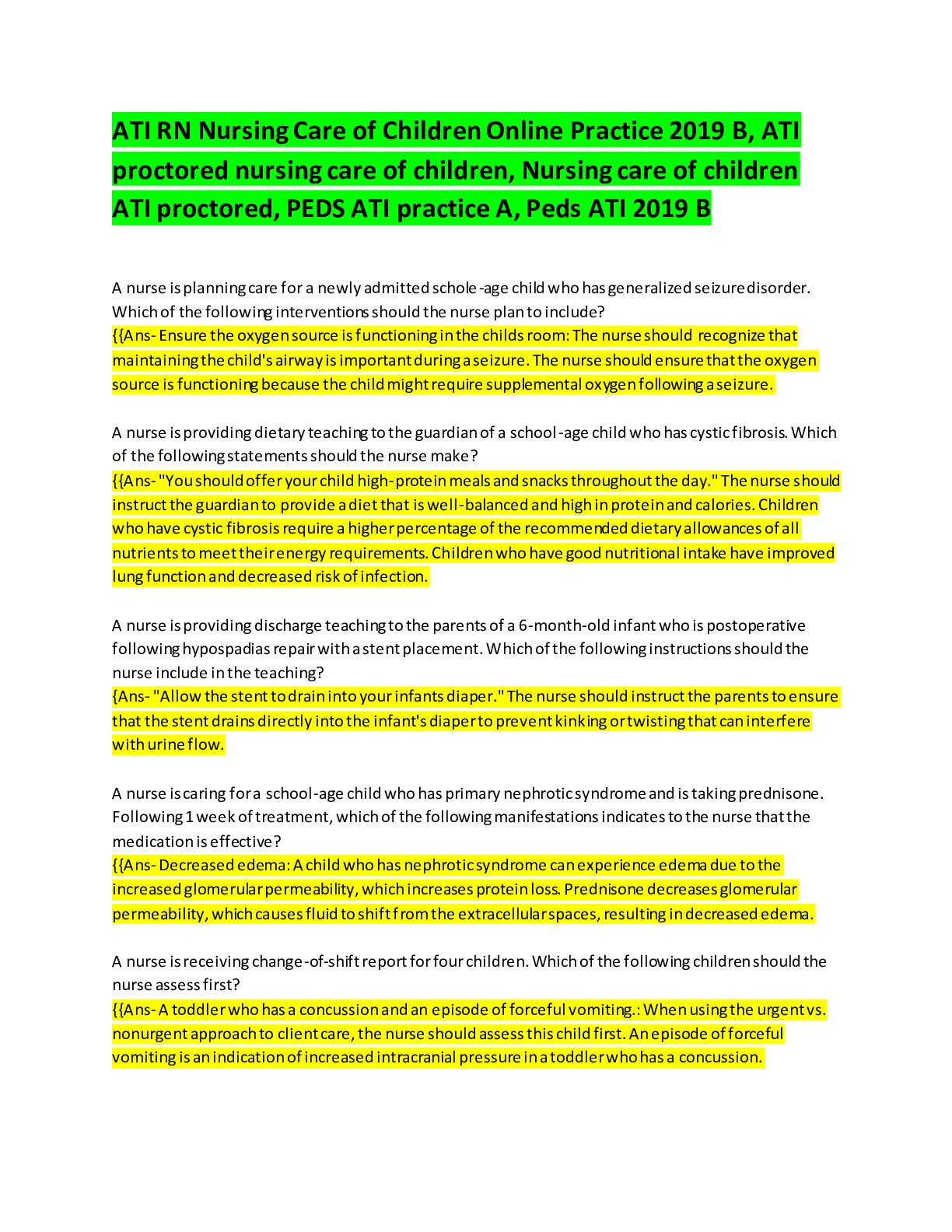
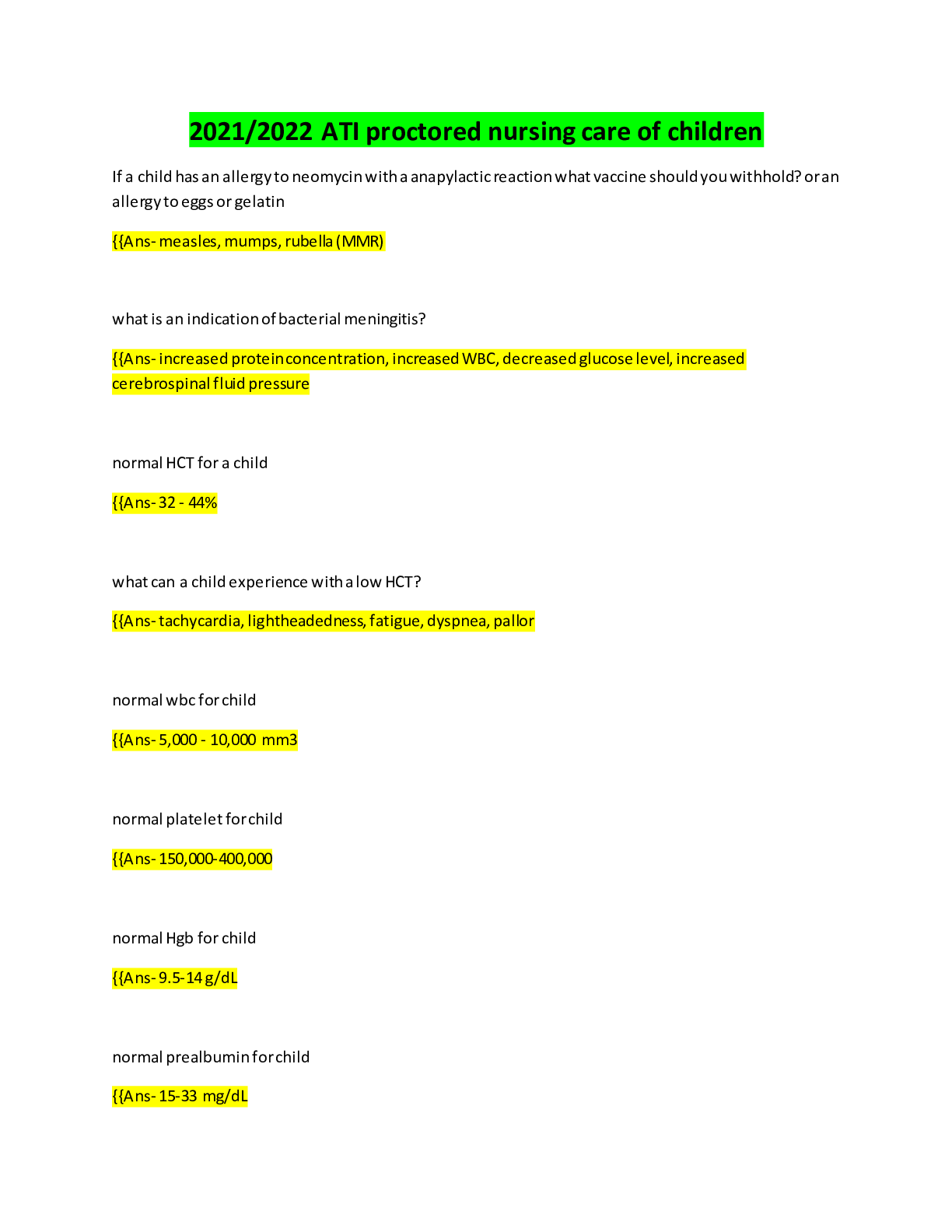


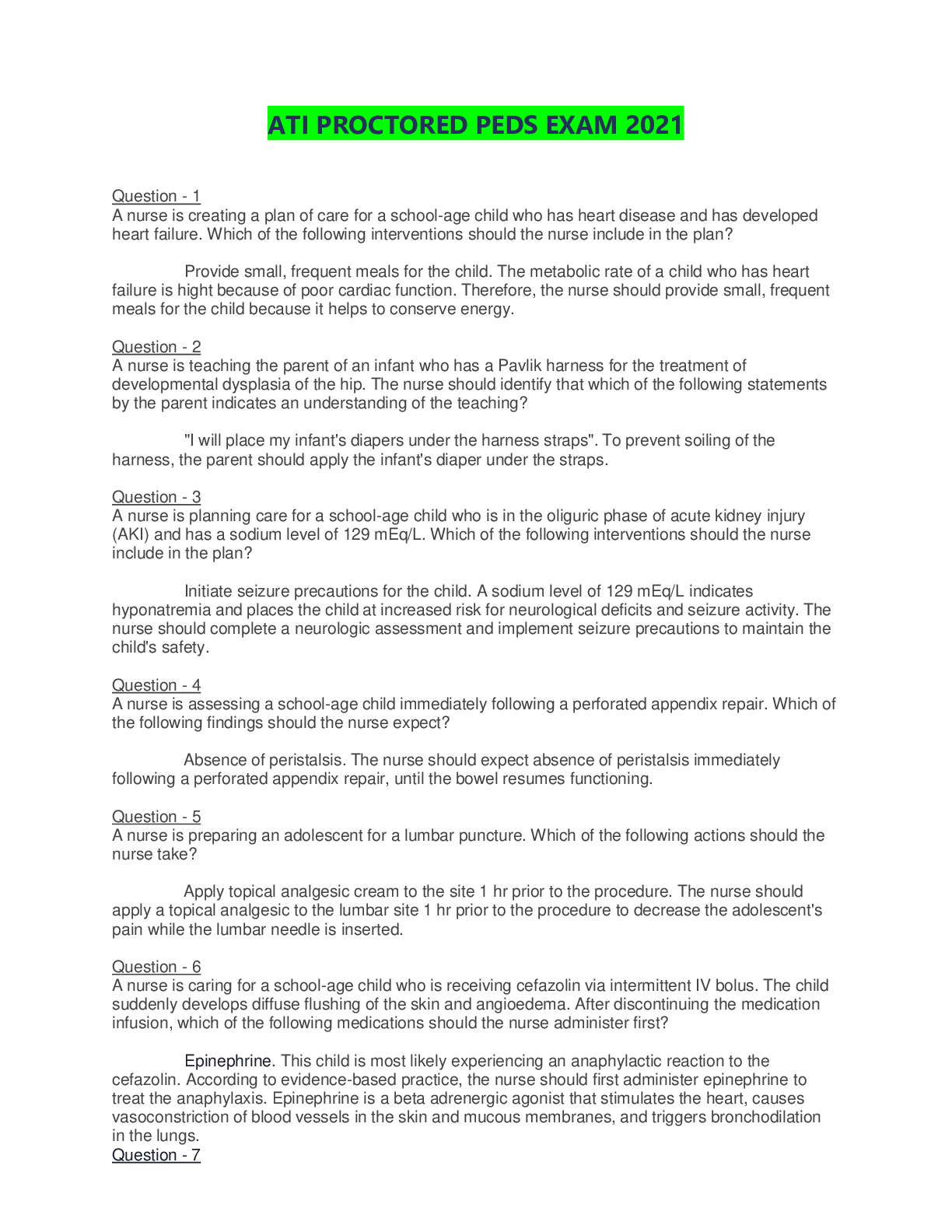
 (1).png)
 (1).png)
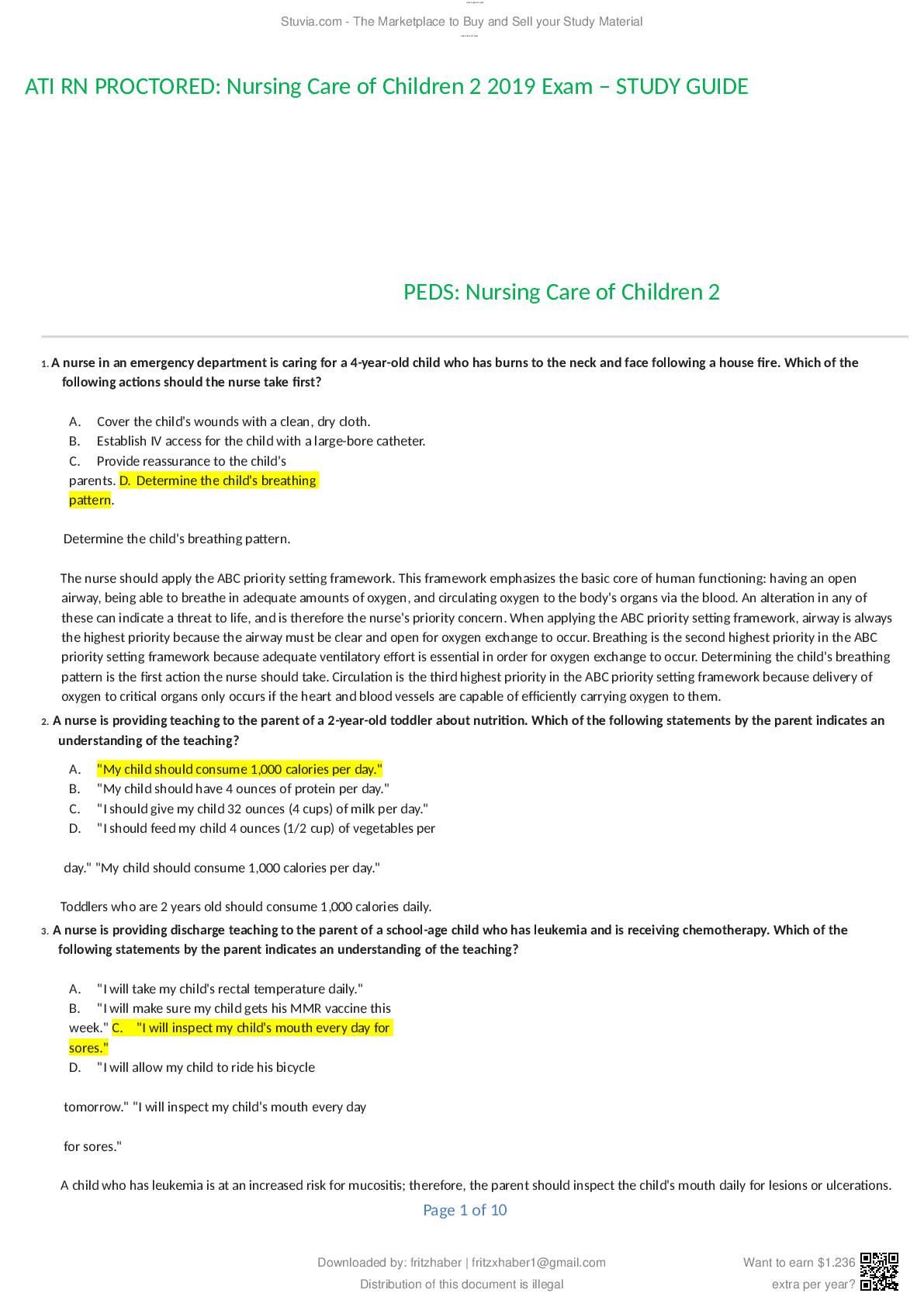
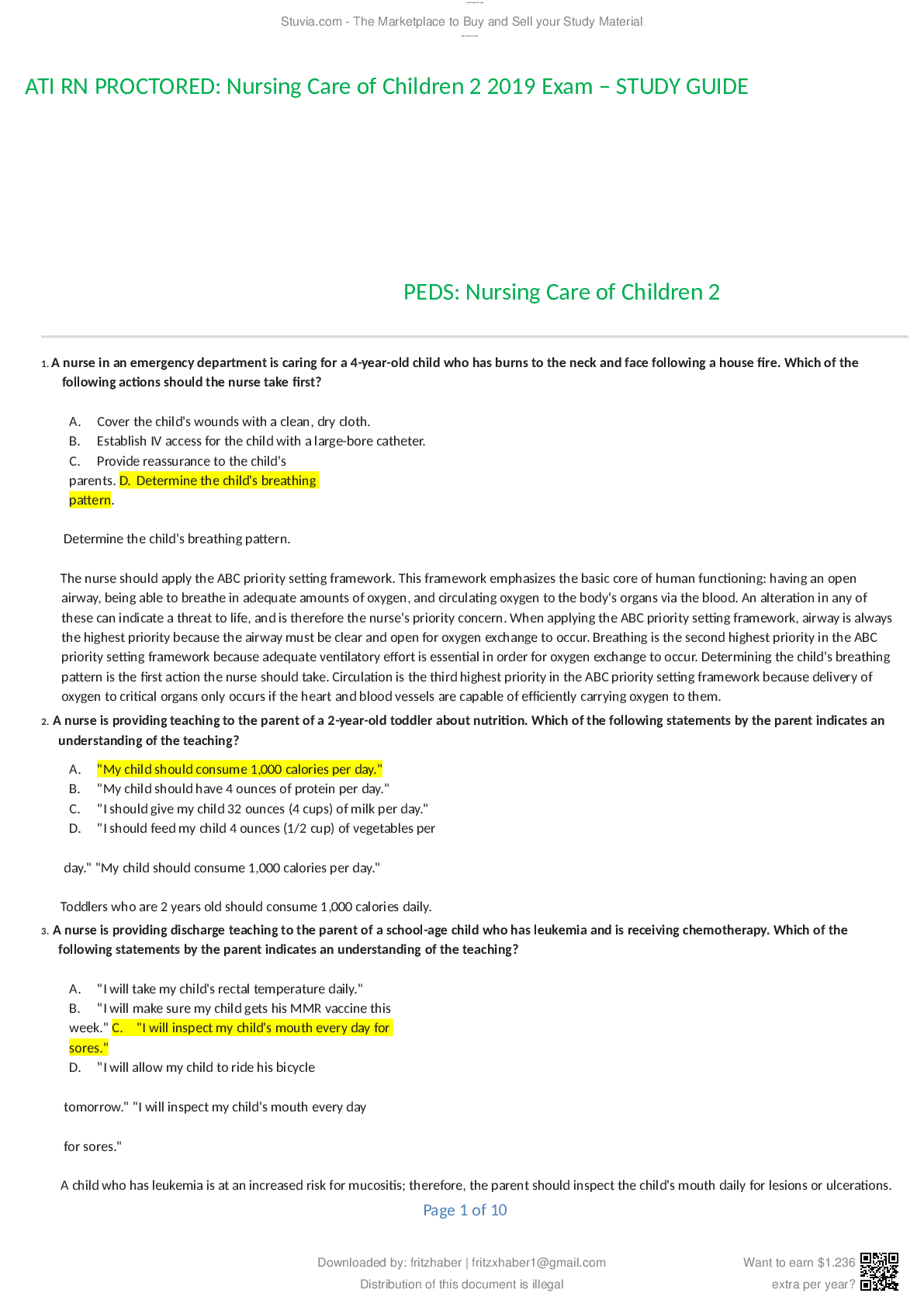
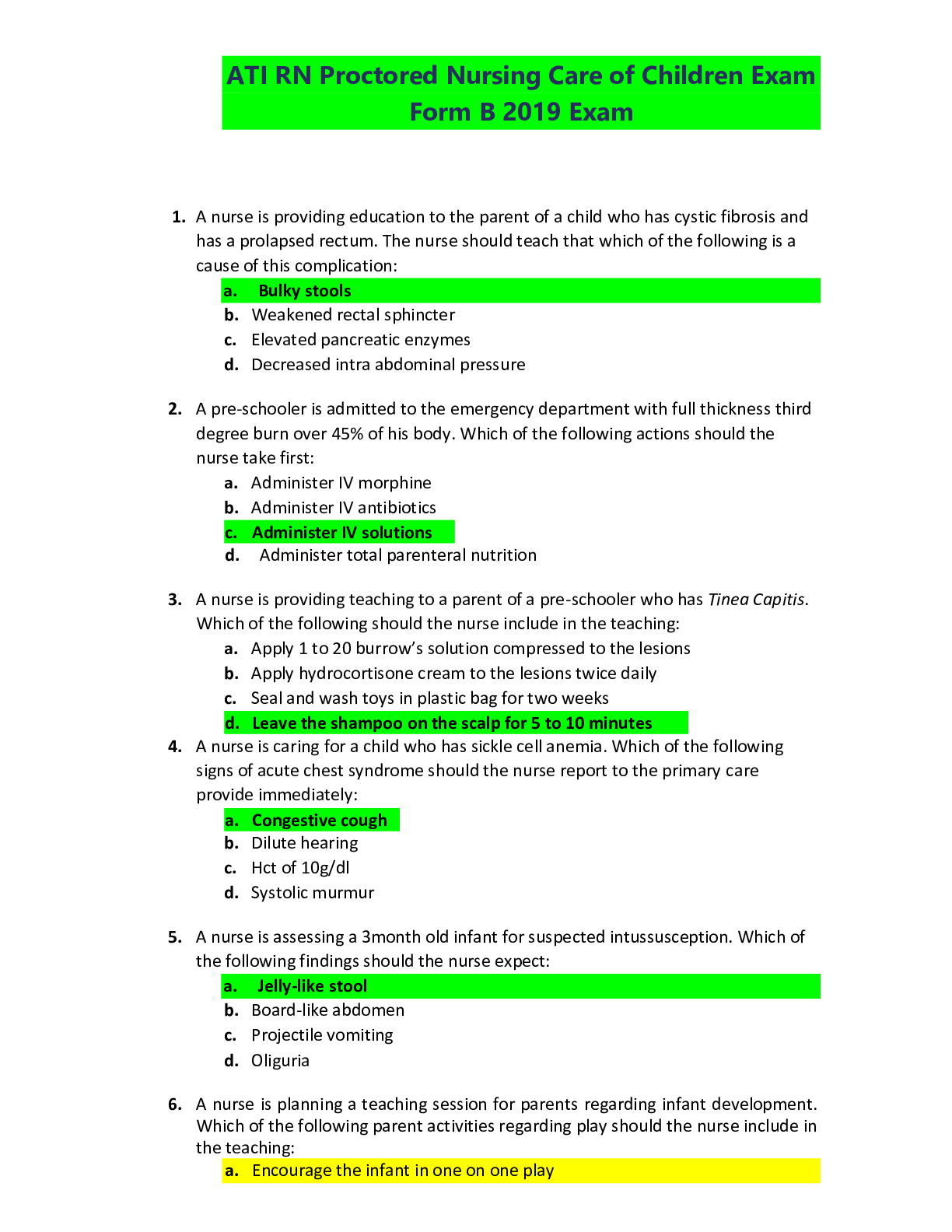
.png)
_1.png)

